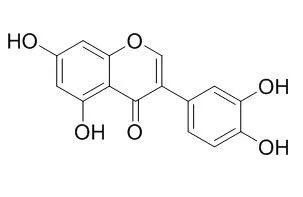| Kinase Assay: |
| Oncol Rep. 2007 Jul;18(1):195-201. | | Differential regulation of the cytotoxicity activity of paclitaxel by orobol and platelet derived growth factor in human ovarian carcinoma cells.[Pubmed: 17549368] | Paclitaxel (PX) binds to and stabilizes tubulin, preventing depolymerization, and resulting in cell death. Based on a previous report showing the activity of phosphatidylinositol kinase (PIK) on tubulin, we investigated the effect of the PI4K inhibitor Orobol and the PI3K activator platelet derived growth factor (PDGF) on PX sensitivity.
METHODS AND RESULTS:
Drug sensitivity was examined by classical colony forming assay. Tubulin isotype expression was determined by semi-quantitative RT-PCR. Microtubule texture was observed by laser confocal microscope using anti-beta-tubulin antibody. Apoptotic activity was estimated by frequency of condensed nuclear chromatin with Hoechst 33342 stain. Orobol enhanced PX sensitivity of human ovarian carcinoma 2008 cells by 18.9+/-1.2-fold (N=3; P<0.01). In contrast, pretreatment with PDGF rendered cells resistant to PX by 2.3+/-0.4-fold (N=3; P<0.01). Neither Orobol nor PDGF showed any effect on cell growth. Orobol produced a 2.5-fold sensitization in cisplatin-resistant 2008/C13*5.25 (C13) cells, and PDGF rendered the cells 2.3-fold resistant to PX. Orobol suppressed the beta 4a-tubulin isotype expression by 85% and other isotypes by 20%. In contrast, PDGF induced beta 4a-tubulin isotype expression by 1.3-fold, while it supressed all the other isotypes by 20-40%. Orobol produced thick microtubules and PDGF generated ring condensed microtubules. Orobol promoted PX-induced apoptosis, while PDGF caused 50% reduction of apoptosis.
CONCLUSIONS:
These results indicate that Orobol and PDGF regulate PX sensitivity by reciprocally altering the proportion of tubulin isotype expression and PX-induced apoptotic signaling. | | Gynecol Oncol. 2003 Aug;90(2):413-20. | | Enhancement of sensitivity to cisplatin by orobol is associated with increased mitochondrial cytochrome c release in human ovarian carcinoma cells.[Pubmed: 12893210] | Based on our previous report showing that Orobol, a potent phosphatidylinositol 4-kinase (PI4K) inhibitor, produced cisplatin (DDP) sensitivity, we have determined the mechanism of Orobol-sensitization effect.
METHODS AND RESULTS:
Orobol produced >2-fold DDP sensitivity in human ovarian carcinoma 2008 cells and its DDP-resistant variant 2008/C13*5.25 cells (C13). Because Orobol had no effect on conventional mechanisms such as DDP accumulation or cellular metallothionein and glutathione content, we have focused on the apoptotic signaling pathway. Orobol induced a significant increase in apoptosis in DDP-treated cells, as estimated by frequency of condensed nuclear chromatin with Hoechst 33342 stain, although Orobol alone did not have any effect on apoptotic potential. The caspase-3-inhibiting peptide Ac-DEVD-CHO completely inhibited the Orobol sensitization effect but did not block DDP cell cytotoxicity per se. Orobol rendered both of these cells resistant to rhodamine 123 (Rh) by more than 2.5-fold, indicating significant decrease of mitochondrial membrane potential (DeltaPsim). Confocal laser microscopy of cells stained with the mitochondria (MT)-specific dye Rh revealed that Orobol decreased Rh-fluorescent intensity. Electron microscopy of these cells showed that Orobol induced swelling and condensation of MT. Orobol suppressed both naturally expressed and the DDP-induced Bcl-2 expression significantly. Orobol and DDP treatment reduced cytochrome c level in MT determined by Western blot analysis, indicating increased amount of cytochrome c release from MT, whereas Orobol alone did not alter the amount of cytochrome c in MT.
CONCLUSIONS:
These results indicate that Orobol produced DDP sensitivity in human ovarian carcinoma cells by inducing apoptosis through the MT-dependent signaling pathway. | | Antivir. Chem. Chemoth., 1994, 5(2):99-104. | | Orobol: An Inhibitor of Vesicular Stomatitis Virus that Blocks the Synthesis of Viral Nucleic Acids and the Glycosylation of G Protein[Reference: WebLink] | The naturally occurring isoflavonoid Orobol exhibits antiviral effects against some animal viruses.
METHODS AND RESULTS:
Addition of the compound after virus entry inhibits the appearance of late viral protein synthesis in Vesicular Stomatitis Virus, influenza, or vaccinia virus-infected cells, but has no effect on poliovirus protein synthesis. Concentrations of the compound above 10–50 Mg ml−1 are sufficient to decrease the synthesis of VSV proteins when added early during infection, but have no effect on viral translation if added later, indicating that Orobol does not block VSV translation directly.
CONCLUSIONS:
The synthesis of VSV nucleic acids is one of the targets of this flavonoid. The synthesis of both minus and plus-stranded viral RNA are inhibited by Orobol when added during the first 2 h of infection. In addition, this compound interferes potently with the glycosylation of VSV G protein, indicating that Orobol has several targets of antiviral action. The possibility that Orobol interferes with the function of the cellular vesicular system is discussed.
|
|
| Cell Research: |
| Int J Oncol. 2001 Feb;18(2):337-42. | | Differential sensitization by orobol in proliferating and quiescent human ovarian carcinoma cells.[Pubmed: 11172601 ] | The object of this study was to determine how phosphatidylinositol (PI) signaling pathway is involved in the regulation of cisplatin (DDP) sensitivity.
METHODS AND RESULTS:
Clonogenic survival assay was used to determine the effect of Orobol, a potent PI4-kinase inhibitor, on DDP sensitivity in human ovarian carcinoma 2008 cells. Orobol enhanced sensitivity to DDP in 2008 cells by a factor of 2.1+/-0.4 (SD)-fold (N=3; P<0.01). Sensitization was specific for proliferating cells. Orobol did not alter DDP sensitivity in quiescent cells. Orobol also produced a 2-fold increase in sensitivity to DDP in proliferating 2008/C13*5.25 DDP-resistant variants. Our studies indicated that Orobol-induced sensitization depended on the presence of proliferating cells in G2+M phase of the cell cycle. Orobol did not modulate the cellular accumulation of DDP nor did it alter the CdCl2 sensitivity, suggesting that the amount of platinated-DNA was not changed by Orobol treatment. However, Orobol rendered 2008 cells resistant to rhodamin 123 by 5.7+/-1.7 (SD)-fold (N=3, P<0.01).
CONCLUSIONS:
Since sensitivity to rhodamin 123 is indicative of mitochondrial membrane potential, these results imply that mitochondrial alterations may be an important component of the Orobol sensitization effect in these cells. |
|






 Cell. 2018 Jan 11;172(1-2):249-261.e12. doi: 10.1016/j.cell.2017.12.019.IF=36.216(2019)
Cell. 2018 Jan 11;172(1-2):249-261.e12. doi: 10.1016/j.cell.2017.12.019.IF=36.216(2019) Cell Metab. 2020 Mar 3;31(3):534-548.e5. doi: 10.1016/j.cmet.2020.01.002.IF=22.415(2019)
Cell Metab. 2020 Mar 3;31(3):534-548.e5. doi: 10.1016/j.cmet.2020.01.002.IF=22.415(2019) Mol Cell. 2017 Nov 16;68(4):673-685.e6. doi: 10.1016/j.molcel.2017.10.022.IF=14.548(2019)
Mol Cell. 2017 Nov 16;68(4):673-685.e6. doi: 10.1016/j.molcel.2017.10.022.IF=14.548(2019)